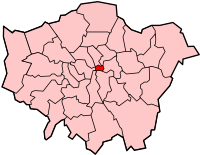City of London
City of London
The City • Square Mile | |
|---|---|
 Skyline in 2019 | |
| Motto(s): Domine dirige nos Latin: Lord, guide us | |
 Shown within Greater London | |
| Sovereign state | United Kingdom |
| Constituent country | England |
| Region | Greater London |
| Status | sui generis, City and Ceremonial County |
| Admin HQ | Guildhall |
| Roman settlement | c. 47 AD (Londinium) |
| Wessex resettlement | 886 AD (Lundenburh) |
| Government | |
| • Local authority | City of London Corporation |
| • Lord Mayor | Michael Bear |
| • MP | Mark Field |
| • London Assembly | John Biggs |
| Area | |
| • Total | 1.12 sq mi (2.9 km2) |
| Population (2005 est) | |
| • Total | 9,200 |
| • Density | 8,220/sq mi (3,172/km2) |
| • Ethnicity | 84.4% White 68.3% British 12.8% non-British 3.3% Irish 6.8% South Asian 2.6% African-Caribbean 2.0% Chinese |
| • ONS code | 00AA |
| Population Ranked 353rd | |
| Time zone | UTC+0 (GMT) |
| • Summer (DST) | UTC+1 (BST) |
| Postal code | |
| Website | http://www.cityoflondon.gov.uk |

The City of London is a district of Greater London.[1] The city's boundaries have remained almost unchanged since the Middle Ages. Although it is now only a small part of the metropolis, it is a notable part of central London. The City holds city status in its own right, and is also a ceremonial county. Often referred to as the City, or the Square Mile, it is just over one square mile, 1.12 sq mi (2.90 km2) in area.[2]
It is here in the City of London where most of the United Kingdom's financial trade is done. It is a very small area, only a square mile, and has a very small resident population (8,000). However, many people come to work here and during the day it can be very busy, with some 300,000 people in it.[3]
"London" now refers to Greater London, which is made up of 32 boroughs (including the City of Westminster and the City of London). The city is in central London and is the oldest part of the city, dating back to Roman times. The City of London has its own mayor, the Lord Mayor of London, an office separate from (and much older than) the Mayor of London. There are other ancient features, dating back to medieval times. The city has its own police force, the City of London Police.
Financial markets[change | change source]
The City vies with New York City as the financial capital of the world: many banking and insurance institutions have their headquarters there. The London Stock Exchange (shares and bonds), Lloyd's of London (insurance), the London Metal Exchange and the Bank of England are all based in the city.
Over 500 banks have offices in the city, and the city is an established leader in trading in Eurobonds, foreign exchange, energy futures, metals, and global insurance. The Alternative Investment Market, a market for trades in equities of smaller firms, is a recent development. In 2008, the City of London accounted for 4% of UK GDP.
London is the world's greatest foreign exchange market, with much of the trade conducted in the City of London. Of the $3.98 trillion daily global turnover, as measured in 2007, trading in London accounted for around $1.36 trillion, or 34.1% of the total.[4] The Pound Sterling, the currency of the United Kingdom, is globally the fourth most traded currency and the third most held reserve currency.
Since 1991 Canary Wharf, a few miles east of the City in Tower Hamlets, has become a second centre for London's financial services industry and houses many banks and other institutions formerly located in the Square Mile. This development does not appear to have damaged the city: both places have grown.
History[change | change source]
The city is the site of Roman Londinium, and the archaeological remains are on display in the Museum of London, City Wall.
The city has many churches designed by Sir Christopher Wren, including St Paul's Cathedral. The city was the site of the Great Fire of London in 1666.
References[change | change source]
- ↑ Beckett, J V (2005). City status in the British Isles, 1830–2002. Historical urban studies. Aldershot: Ashgate. p. 12. ISBN 0-7546-5067-7.
- ↑ "City of London Resident Population Census 2001" (PDF). Corporation of London. July 2005. Archived from the original (PDF) on 2012-09-12. Retrieved 2009-04-10.
- ↑ "City of London still tops finance league". This is Money. 2011-03-25. Retrieved 2011-10-30.
- ↑ BIS Triennial Central Bank Survey, published in December 2007.


